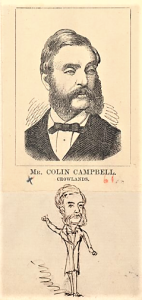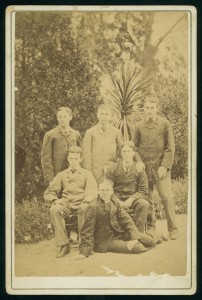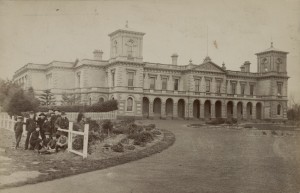Within a few years of Victoria being declared a separate colony in 1851, its legislature voted to grant £35,000 for the establishment of grammar schools – schools intended to prepare scholars for the newly-established University of Melbourne. After some deliberation, it was decided to distribute the funds amongst the four leading religious denominations; and five schools, known as ‘public grammar schools’ were founded – four in Melbourne and one in Geelong; namely, Melbourne Grammar School, Geelong Grammar School, Scotch College, Wesley College, and St Patrick’s College. All the schools were conducted by the churches, independent of any government control or oversight. The decision to allocate the grants to the religious denominations, rather than to the existing educational boards responsible for administering the government-aided schools, had important long-term consequences for the development of secondary schooling in Victoria.
Why the name ‘public grammar school’?
The term ‘public grammar school’ was used in official documents and papers during the nineteenth century to describe five grammar schools founded with the aid of parliamentary grants. An educational report, published in 1870, identified a ‘public grammar school’ as ‘a school subsidised by the state’; although this was somewhat misleading, as the subsidy comprised a large initial endowment, plus a grant of land, but no ongoing funding. Nevertheless, such schools were initially in receipt of public money.
The term ‘public school’ had several different meanings during the nineteenth century. It was frequently used in relation to schools supported by public funds and operated by the state – hence the ‘Public Schools’ of New South Wales. But in the English context, a ‘public school’ had come to mean an independent fee-paying grammar school. Most of these public schools had evolved from the long-established endowed grammar schools. Unlike a private school, which was conducted for private profit by an individual, or individuals, or a proprietary institution (owned by shareholders), a public school was a school conducted ‘in the public interest’ by a governing body (definition provided by the Headmasters’ Conference). The British Prime Minister, Gladstone, said that the schools were ‘public property’. (Further definition of ‘public’ and ‘private’ schools occurs in this dictionary.)
An important characteristic of public schools was they were open to all who could afford to pay the fees While this excluded those unable to meet this requirement, pupils were not excluded on social or religious grounds as occurred in many non-public church-owned and private schools.
The word ‘grammar’ indicated the type of education provided – typically a classical education, as had been available in English endowed grammar schools; although increasingly with the inclusion of commercial and scientific subjects. Today such schools would be said to provide a secondary education.
What led to the establishment of the public grammar schools?
The public grammar schools were established during a period when Victoria was experiencing a rapid increase in both population and wealth, following the gold discoveries of the early 1850s. The burgeoning school-age population had access to a variety of educational institutions, but a lack of other viable options meant the state assumed the role of the main provider of schooling. Generous annual government grants, administered by two boards of education – the Denominational School Board (DSB) and the National Board – were used to establish schools throughout the colony. These institutions offered predominantly what would now be called primary education, but during a period when there was no clear demarcation between the primary and secondary stages of schooling (and many pupils attending were aged in their mid-to-late teens), tuition was frequently offered in advanced, or ‘higher’, subjects.
In 1853, the Victorian legislature passed an act to establish a state-funded university in Melbourne, entry to which was by means of a matriculation examination undertaken at the conclusion of a pupil’s schooling. Once the university was operational (from 1855), it meant that the colonial government had assumed responsibility for funding the early (elementary) and final (university) stages of education, but not for the intermediary (secondary) stage. Although some private schoolmasters and religious organisations claimed to offer a secondary education – variously described as ‘higher’, ‘advanced’, ‘superior’, or ‘grammar school’ – there was no guaranteed ongoing provision as many institutions were ephemeral in nature.
During the early 1850s, both the DSB and the National Board had been approached by various bodies that sought funding for the establishment of post-elementary, ‘secondary’, schools, but neither had been able to provide assistance, due to financial restraints. When, in early1853, the DSB was asked by the Committee of Synod of the Free Presbyterian Church to provide £4,000 – £5,000 towards the erection of buildings for its Academy (forerunner to Scotch College), it was unable to assist as it had only limited funds for the Presbyterian Church at its disposal. Subsequently, the Lieutenant-Governor, Charles La Trobe, asked the DSB to provide a report on the provision of higher (secondary) education in the colony.

Colin Campbell in 1874. Artist: Edward Gilks. Courtesy State Library of Victoria
Report on the establishment of ‘superior schools’
Colin Campbell, acting secretary to the DSB, forwarded a report to the Colonial Secretary in April 1853. The main observations and recommendations were as follows:
(1) That the expenditure on the establishment of the University of Melbourne would be ‘thrown away’ without the provision of ‘superior schools’ interspersed between the elementary schools and the university
(2) That the existing private schools could not be extended to meet the need
(3) That the most direct mode of providing superior schools would be to give aid towards the erection of buildings
(4) That £20,000 to establish the proposed schools be placed on the supplementary estimates
(5) That the superior schools should be subject to ‘suitable inspection’, and their constitutions with regard to management be clearly defined.
The Executive Council met to discuss Campbell’s report, and on May 1853 the Legislative Council approved that £20,000 ‘For the Erection and Support of Grammar Schools’ be placed on the supplementary estimates for 1854.
Although it acted swiftly to provide the necessary funds for the establishment of the schools, the government then stalled in deciding how the money was to be distributed. Despite several attempts by La Trobe, the matter had not been resolved by the time he left the colony in May 1854.
Eventually, at a meeting of the Executive Council held in June, three options for the distribution of the grants were put forward. These were:
- The funds be distributed to existing and future applicants.
- The funds be given to the two existing boards.
- The funds be distributed to the heads of the leading religious denominations.
When, finally, a decision was reached in August 1854, it proved disappointing for the DSB and the National Board, both of which had expressed an interest in the foundation and administration of the grammar schools. The DSB had argued that state-assisted schools should be established, as was the case in Continental Europe. But neither board was to receive any of the funds; instead, the money was to be given ‘to the four principal denominations … according to their numerical portions as shown in the Census of 1851’. This meant that the government grants were to be placed in the hands of nongovernment organisations, without any oversight by the state – the recommendation by Campbell that the schools should be open to inspection was ignored.

Melbourne Grammar School, a ‘public’ school. 1932. Artist: Victor Cobb. State Library of Victoria.
Consequences of the decision
The initial grant of £20,000 for the erection and establishment of grammar schools was supplemented by a second grant of £15,000, voted in 1856. The recipients of the funds were the Church of England, the Roman Catholic Church, the Presbyterian Church and the Wesleyan Church. The grants allowed for the establishment of five public grammar schools – the Anglican Church had sufficient funds to found two schools, and the other denominations founded one school each. Four were located in Melbourne, one in Geelong, and all were attended by boys only; at the time girls were unable to study at the university, or even to sit for the matriculation examination.
The public grammar schools
The names of the schools, their denominational associations, the dates of foundation as a public grammar school (some had an earlier connection with a private institution), and the size of the establishment grants (recorded annually in the Victorian Parliamentary Papers until the early twentieth century) are listed.
Scotch College, Presbyterian Church, 1855, £6,445-00-00*
Melbourne Grammar School, Church of England, 1858, £13,783/14/00
Geelong Grammar School, Church of England, 1858, £7,000/00/00
St Patrick’s College, Roman Catholic, 1855, £2,500/09/00**
Wesley College, Wesleyan Church, 1866, £2,759/09/00
Total: £32,498-12-00
* Of the schools that had an association with an earlier private institution, only Scotch College could be said to have had a direct connection – the Academy founded in 1851.
**The amount initially allocated to the Roman Catholic denomination does not correspond to the proportion it should have received but this was amended after the establishment of St Francis Xavier College in 1878. In the Parliamentary Papers the two Catholic schools were bracketed together with a note that the latter was a branch of the former. The amount said to have been received for the combined institutions was £10,002, therefore making the total £40,000.

Boys from the one public grammar school outside of Melbourne, Geelong Grammar. 1880. State Library of Victoria
Early history of the public grammar schools
Four of the five public grammar schools were located in Melbourne, and therefore competed in a restricted market for the patronage of the parents of boys who sought the type of education they offered. Meanwhile the rest of the colony, other than Geelong, was unprovided for.
Not only did an individual school face competition from the other public grammar schools, but also from a growing number of private institutions. This meant all were vulnerable economically, and such was their financial instability that two, Geelong Grammar and St Patrick’s College, were forced to close for some years during the 1860s – and a third, Wesley College, was insolvent for a time.
The Geelong Grammar School (GGS), despite being the only public grammar school outside Melbourne, and located in a large regional city, faced competition from a National Board school – the Geelong National Grammar School. After the debt of the Geelong Grammar School reached £7,000, the trustees decided to close the school in June 1860. According to a contemporary newspaper, its demise was ‘our great Victorian muddle, one of the largest and rankest of our failures – the terror and scandal of the Church of England’. After the trustees failed to persuade the government to purchase the building and resume the land for a proposed juvenile reformatory, the school reopened in February 1863, but for many years was burdened with a large debt.
Similarly, St Patrick’s College closed in 1863 with an accumulated debt of £5,000. Within two years the school was taken over by the Jesuits, and then operated in tandem with St Francis Xavier College.
Wesley College also experienced financial difficulties, to the extent that by 1897 its debt had reached £15,000. The committee agreed that the school would be sold if a buyer could be found. As it was clear that the debt exceeded the value of the building and land, no purchaser came forward and the school survived.
However, after some initial problems, the public grammar schools began to establish a reputable standing within the community: their success depended on the patronage they could attract, and this in turn depended on their reputation; a reputation largely based on the success of pupils at the public examinations. The results of students at the matriculation and public service examinations featured prominently in advertisements, prospectuses, and at annual speech days, and were used as a promotional tool.
Examination success by public grammar school students was facilitated by the establishment of government exhibitions and scholarships. From 1871 the Board of Education funded eight (later 11) exhibitions to allow scholars from government-aided schools to attend the public grammar schools for three years and then the University of Melbourne for another three. Then, in 1886, a scheme was introduced whereby each year 200 government school pupils were awarded scholarships worth £10 per annum to attend nongovernment secondary schools for three years. In 1895 the Minister for Public Instruction acknowledged that since 1872 the government had awarded 233 exhibitions and 1,175 scholarships; a significant number at a time when only a relatively small percentage of scholars completed secondary school.
These former government school scholars were important in helping the public grammar schools secure examination passes, and therefore reputational success. In 1890 for example, 91 of the 365 pupils at Scotch College were scholarship holders – approximately 25 percent – and it was expected that they would comprise a much greater percentage in the later years of schooling.

Wesley College in Melbourne, the Methodist public grammar school. c. 1905. State Library of Victoria
Historical development and consequences for Victorian secondary education
In their analysis of the secondary schools attended by the Victorian men listed in the 1988 edition of Who’s Who in Australia, Mark Peel and Janet McCalman (1992) noted that over 41 per cent of entrants had attended a small group of protestant corporate schools; namely, Melbourne Grammar School, Geelong Grammar School, Scotch College, Wesley College, and Geelong College – all but the last being a public grammar school. By contrast, the majority of men from New South Wales listed in the publication had attended government high schools. The difference in the educational background of entrants from the two largest Australian states is a direct consequence of political decisions made during the nineteenth and early twentieth centuries.
In the same year that the Victorian legislature decided to fund the establishment of publicly-endowed denominational grammar schools, the government of New South Wales passed an Act of Parliament to found and endow (with an annual grant of £1,500), the secular Sydney Grammar School. Subsequently the government established a number of high schools, as well as allowing advanced tuition to be provided in superior public schools to the extent that 11,500 pupils were enrolled at the superior schools by 1904. At this time not one government-funded secondary school had been established in Victoria, and the only option for pupils attending Victorian government schools who sought a higher education, was to receive tuition in ‘extra’ (higher) subjects, outside regular school hours, on payment of additional fees.
The first Victorian government secondary school, the Melbourne Continuation (later High) School, opened in 1905. Subsequent expansion of secondary education proceeded slowly, especially in Melbourne, as a clause in the 1910 Education Act (legislation that provided for the foundation of high schools) specified that government schools could not be established ‘unless the Minister is satisfied that adequate provision does not exist in the locality for secondary education of an approved kind.’ This provided protection from competition for nongovernment schools, and as a result there were no full high schools in the eastern and southern suburbs of Melbourne until the late 1950s. (See dictionary entry on the foundation of government high schools in Australia.)
According to Peel and McCalman, ‘the most prestigious schools attract the ambitious and talented. Nongovernment schools lure clever students with scholarships … prestige builds on prestige and success breeds even more success’ (1992 p. 71). The establishment of a comprehensive system of secondary schools in Victoria came too late to challenge the dominance of the nongovernment institutions, particularly those positioned at the top of the hierarchy, the public grammar schools.
The decision to give the funds to the religious denominations to establish schools where they wished, and answerable to no external authority, was to have significant consequences for the development of secondary education in Victoria. Had the boards been given access to the funds, or had some form of governance or oversight been imposed, the history of secondary schooling in Victoria would most likely have been markedly different.
